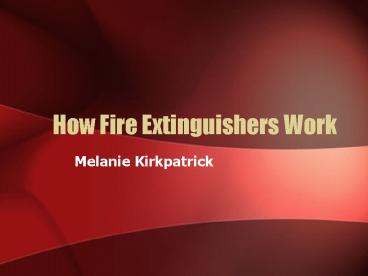How Fire Extinguishers Work - PowerPoint PPT Presentation
1 / 12
Title:
How Fire Extinguishers Work
Description:
How Fire Extinguishers Work. Melanie Kirkpatrick. FIRE. The three essential elements of a fire are: ... Many kitchens still use Class B. Carbon Dioxide Extinguishers ... – PowerPoint PPT presentation
Number of Views:119
Avg rating:3.0/5.0
Title: How Fire Extinguishers Work
1
How Fire Extinguishers Work
- Melanie Kirkpatrick
2
FIRE
- The three essential elements of a fire are
- Heat
- Oxygen
- Fuel
- To put out a fire, you need to remove one of
these elements.
3
Inside the Fire Extinguisher
http//home.howstuffworks.com/fire-extinguisher1.h
tm
4
Class A
- Ordinary combustible materials
- Air-Pressurized Water Extinguisher
- Class A Extinguishers have a rating such as 4-A.
- The number indicates how much water the
extinguisher holds. One unit equals 1.25
gallons. So a 4-A extinguisher holds 41.255
gallons
5
Class B
- Flammable Liquids
- Usually a Carbon Dioxide Extinguisher
- Has a number rating such as 10-B, which
represents the area in square feet of a Class B
fire the extinguisher can put out
6
Class C
- Electrical Equipment
- Usually a Dry Chemical Extinguisher, but can also
be Carbon Dioxide
7
Class D
- Combustible Metals
- Different Metals have very different reactions to
burning so there is no one type of agent approved
for all Class D Fires
8
Class K
- Kitchens and environments with a high probability
of grease fires - Wet potassium acetate based, low pH agent
- Class K extinguishers are rare because they have
only existed since 1998 - Many kitchens still use Class B
9
Carbon Dioxide Extinguishers
- Puts out fires by eliminating oxygen and
replacing it with CO2 - Dry ice can sometimes come out
- Should only be used on Class BC Fires
Label of a CO2 Class BC extinguisher
10
Dry Chemical Extinguishers
- Classified as ABC or BC
- Usually sodium bicarbonate, potassium
bicarbonate, or monoammonium phosphate - Coat fuel and smother fire
A Dry Chemical Potassium Bicarbonate Extinguisher
11
Halon Fire Extinguishers
- Contains a gas which interrupts the chemical
reaction when fuels burn - Used to protect valuable electrical equipment
- Used on Class ABC fires
- Bromochlorodifluoromethane, halon 1211, used as
its extinguishing agent
12
Bibliography
- http//home.howstuffworks.com/fire-extinguisher.ht
m - http//www.fire-extinguisher101.com/index.html
- http//www.hanford.gov/fire/safety/extingrs.htm
- http//home.howstuffworks.com/question346.htm
- http//en.wikipedia.org/wiki/Fire_extinguishers
- http//www.osha.gov/SLTC/etools/evacuation/portabl
e_about.html - http//www.pp.okstate.edu/ehs/MODULES/exting/Trian
gle.html - http//www.uncg.edu/sft/extinguisher2A.html
- http//www.dcfp.navy.mil/equip/pkp.htm
- http//www.lhup.edu/ehs/FireSafetyPcy/Fire20Extin
guisher20Info20Sheet.htm

